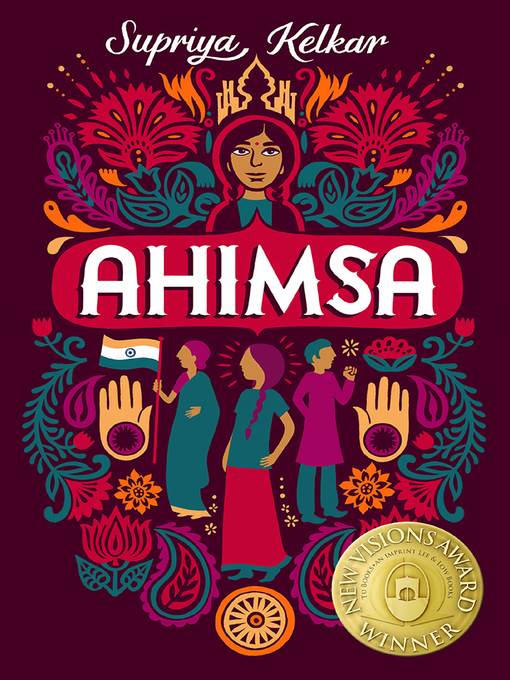
Ahimsa
فرمت کتاب
ebook
تاریخ انتشار
2017
Lexile Score
830
Reading Level
4-5
ATOS
5.3
Interest Level
4-8(MG)
نویسنده
Supriya Kelkarناشر
Lee & Low Booksشابک
9781620143575
کتاب های مرتبط
- اطلاعات
- نقد و بررسی
- دیدگاه کاربران
نقد و بررسی

August 7, 2017
Set in a fictional Hindi-speaking Indian town in 1942, Kelkar’s debut is inspired by the life of her great-grandmother, who was active in the Indian independence movement led by Gandhi. The novel smoothly and realistically depicts the complex segregated world of India in those years, including characters from different castes. Told from the point of view of 10-year-old Anjali Joshi, a high-born Brahmin, the story traces the development of the nonviolence (Ahimsa in Hindi) movement and the Hindu-Muslim conflicts that arose at the time, along with the effects of both on one community and, especially, on Anjali’s family. When Anjali’s mother becomes a nonviolent activist fighting for Indian independence and social justice among the castes, Anjali—who is initially horrified by the her mother’s actions—gets swept up in the causes, focusing especially on treating the untouchables, whom she learns to call Dalits, as equals. Kelkar builds compelling tension, which leads to grim outcomes, while highlighting Anjali’s resulting bravery and maturity. An author’s note provides historical background, and a glossary of Hindi words is included. Ages 8–12. Agent: Kathleen Rushall, Andrea Brown Literary.

Starred review from September 1, 2017
Gr 4-6-Ten-year-old Anjali's comfortable life changes dramatically when her parents decide to honor Mahatma Gandhi's request that every Indian family give one member to the fight for freedom from British rule. Anjali's mother takes the active role, first learning to spin cotton on the charkha in order to make khadi, or homespun clothes, and teaching others to do the same. Her aspirations expand to helping the Dalit community, referred to with the pejorative "untouchables" by most in the town. It is Anjali's observation that the Dalit children in their town should be able to go to school, and Ma is determined to make that happen. The road ahead is not smooth, as violence breaks out between Hindus and Muslims in their town and across the country, and Ma and other freedom fighters are jailed unjustly for their efforts, though they follow the principles of "ahimsa," or nonviolent resistance. Anjali continues her mother's crusade to integrate their school, knowing that before she can change others' beliefs, she must first change her own. Inspired by the author's great-grandmother, this well-written, accessible middle grade debut is powered by strong, fully developed characters who make mistakes and learn over the course of the story. Anjali and Ma in particular, though well-intentioned, are guilty of several missteps, which make them even more realistic and relatable to readers. They learn that change is not easy or straightforward, and Anjali especially learns how important it is to recognize and confront inequality. VERDICT A historical, timely, and informative story that is full of heart and belongs in most library collections.-Amanda Raklovits, Champaign Public Library, IL
Copyright 2017 School Library Journal, LLC Used with permission.

Starred review from September 1, 2017
Grades 4-7 *Starred Review* Kelkar's first middle-grade book is filled with female empowerment, hope, family, and the power of nonviolent resistance. It is a tumultuous time: India, 1942. India's freedom fighters, led by Mahatma Gandhi, are trying to overthrow British rule. When her mother takes Gandhi's teachings to heart, Anjali's world is turned upside down. She balks at first as her mother joins the movement and makes the family participate in acts of protest, like burning their clothes or becoming friends with the lowest caste system, the untouchables. Anjali tries to make sense of it, gradually opening her mind to her mother's place in the movement. As she learns about equality and civil liberties, riots erupt around her. When her mother is put in jail, Anjali has to decide if she has the emotional fortitude to practice Gandhi's teachings and continue with the freedom movement. Drawing from her own family history, Kelkar doesn't shy from the reality that progress is slow and that one must persist even when all hope seems gone. Readers will empathize with this heartbreakingly charming debut about the universal struggle of overcoming fears and biases in order to make the world a better place.(Reprinted with permission of Booklist, copyright 2017, American Library Association.)

























دیدگاه کاربران